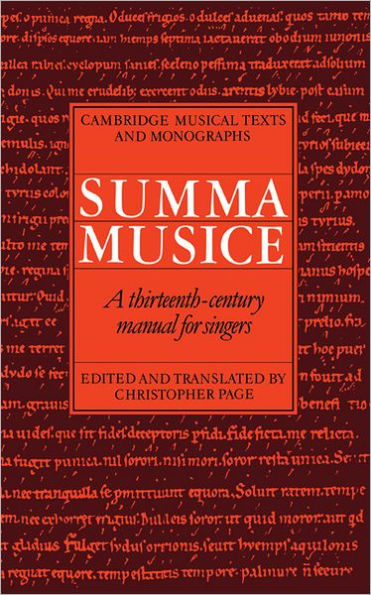Summa Musice: A Thirteenth-Century Manual for Singers
How did medieval musicians learn to perform? How did they compose? What was their sense of the history and purpose of music? The Summa musice, a treatise on practical music from c. 1200, sheds light on all these questions. It is a manual for young singers who are learning Gregorian chant for the first time, and provides a compact but comprehensive introduction to notation, performance, and composition, written in a mixture of Latin prose and verse. More than that, however, it is also an introduction to medieval culture: what educated people believed to be worth knowing about music, how they reasoned when they discussed musical questions, the nature of musical thought and how it was expressed. There has been no edition of the Summa musice since 1784, when Gerbert published a very faulty text. Christopher Page's book provides a completely new edition of the Latin text taken from the only surviving original copy, together with an English translation. Both texts are copiously annotated and introduced by an authoritative and illuminating editorial commentary.
1111442722
Summa Musice: A Thirteenth-Century Manual for Singers
How did medieval musicians learn to perform? How did they compose? What was their sense of the history and purpose of music? The Summa musice, a treatise on practical music from c. 1200, sheds light on all these questions. It is a manual for young singers who are learning Gregorian chant for the first time, and provides a compact but comprehensive introduction to notation, performance, and composition, written in a mixture of Latin prose and verse. More than that, however, it is also an introduction to medieval culture: what educated people believed to be worth knowing about music, how they reasoned when they discussed musical questions, the nature of musical thought and how it was expressed. There has been no edition of the Summa musice since 1784, when Gerbert published a very faulty text. Christopher Page's book provides a completely new edition of the Latin text taken from the only surviving original copy, together with an English translation. Both texts are copiously annotated and introduced by an authoritative and illuminating editorial commentary.
156.0
In Stock
5
1

Summa Musice: A Thirteenth-Century Manual for Singers
294
Summa Musice: A Thirteenth-Century Manual for Singers
294Hardcover(New Edition)
$156.00
156.0
In Stock

Product Details
| ISBN-13: | 9780521404204 |
|---|---|
| Publisher: | Cambridge University Press |
| Publication date: | 08/30/1991 |
| Series: | Cambridge Musical Texts and Monographs |
| Edition description: | New Edition |
| Pages: | 294 |
| Product dimensions: | 5.98(w) x 9.02(h) x 0.83(d) |
From the B&N Reads Blog
